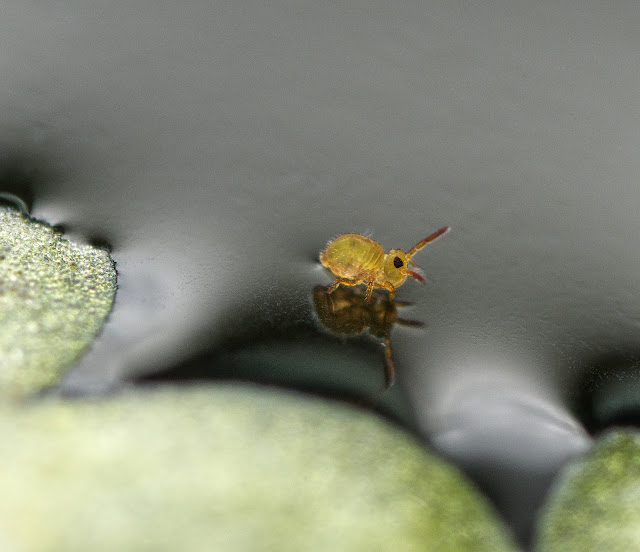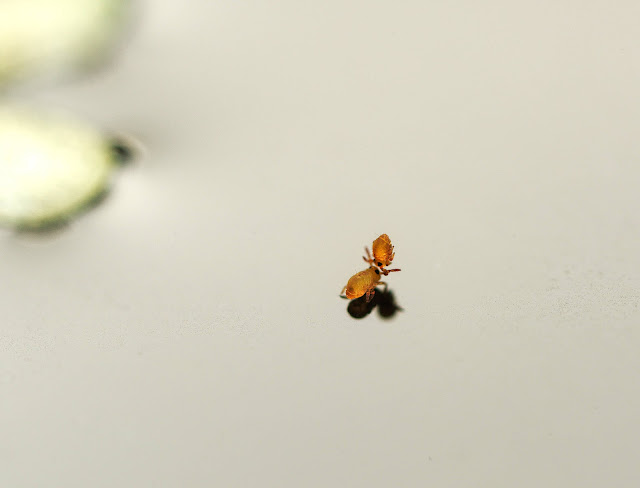
AJC Springtails
Springtails of Leicestershire and Rutland
Friday, 3 October 2025
Shrinking Springtails

Wednesday, 16 July 2025
Entomobrya petri
McCulloch, J.I. (2025) Entomobrya petri sp. nov.: A new species of springtail found in the British Isles. Soil Organisms 97 (2). https://doi.org/10.25674/476
"A new species of elongate springtail (Collembola: Entomobryomorpha) is described from a churchyard in Edinburgh: Entomobrya petri sp. nov. Microscopic examination of specimens from another site in the UK supports that this new species represents the taxon previously referred to as "Entomobrya nr. imitabilis", which is widespread in the British Isles. As well as that of the examined specimens, the ecology and distribution of the morphospecies generally is discussed."
Monday, 21 April 2025
Springtails on NBN
Thanks to the hard work of James McCulloch & Duerden Cormack more than 6,000 springtail records have been imported from iRecord and are now available on the NBN Atlas, bringing the total number of records online to over 26,000. This is a major milestone for springtail recording and will stimulate further records.
Sunday, 16 February 2025
Another instance of DNA not helping
Friday, 24 January 2025
Finally some good news
2024 was a very sad year when we lost some major figures in the springtail community. Frans Janssens was an enormous help to me when I started recording springtails and I was sad to hear of his passing. I also learned so much from Peter Shaw that I felt this additional loss keenly. Fortunately, 2025 begins on a brighter note with the news that James McCulloch has taken over the UK Springtail Recording Scheme. James is a highly knowledgeable springtail enthusiast, and even better, has already started verifying springtail records submitted via iRecord, a daunting task which has not happened before. All this is very positive for the future and I am encouraged by this positive development.
Sunday, 2 October 2022
Sminthurides malmgreni
For the past ten years the aquarium housing my ancient Axolotl has also been home to a colony of Sminthurides malmgreni. I have done nothing to maintain them, but they happily persist wandering around on the surface of the water, on and off the 1.5mm long leaves of the Common Duckweed, Lemna minor.
Inevitably on Springwatch, someone gets shipped off to Scotland to be eaten alive by midges and film the Red Deer stags locking antlers during the rut. If I want to watch rutting, I have no need to move further than the corner of my study, where the emancipated females lift the smaller males off their feet and wander off with them whenever they feel the urge.
Friday, 24 September 2021
Thursday, 3 December 2020
Into the darkness
I've been playing with darkfield microscopy - poor man's phase contrast. Darkfield uses obliqe illumination as a cheap optical trick to increase the contrast of transparent and traslucent specimens. It can produce dramatic images with dark backgrounds and usually features prominently in microscope photography competitions such as Nikon's Small Worlds. I started out with the somewhat translucent furca of a handy Isotomurus unifasciatus specimen. On the left is my conventional setup of top plus bottom illumination, post processed; on the right darkfield transillumination, both stacked with Zerene:
Thursday, 4 June 2020
Sminthurus viridis ssp. cinereoviridis

I have to admit that springtails have been on the back burner recently while I've been focusing mostly on spiders. The weather hasn't helped but it's not an excuse, mostly I've been working on spiders. I have been recording springtails regularly, but I haven't posted anything publicly because I haven't found anything particularly interesting - until today. This morning the vacuum sampler turned up a whole bunch of these. After some rusty fumbling, they keyed out to be Sminthurus viridis (which I have found several times recently), but specifically Sminthurus viridis ssp. cinereoviridis (thanks to Frans Janssens for help with the I.D.).
Sminthurus viridis ssp. cinereoviridis has 2 spots on small abdomen. In the ecovariant nigromaculatus of S. viridis, 3 spots are present: https://www.collembola.org/images/stach/1956/Sminthurus-viridis-1956-J-Stach-Poland-PlateXXXII-Fig3.jpg There are supposedly difference in chaetotaxy of the setae on the subcoxa of the third leg, but I have found it impossible to image these. Steve Hopkins was reluctant to accept nigromaculatus as a separate species. As a dyed-in-the-wool taxonomic lumper, I wouldn't disagree. Frans Janssens calls it "Sminthurus viridis (ecovariant nigromaculatus)", which is said to be associated with sandy areas, heathland, moors, heather, etc. My specimens came from the wettest of wet water meadows alongside the River Soar and have 2 abdominal spots, so Sminthurus viridis ssp. cinereoviridis it is.







